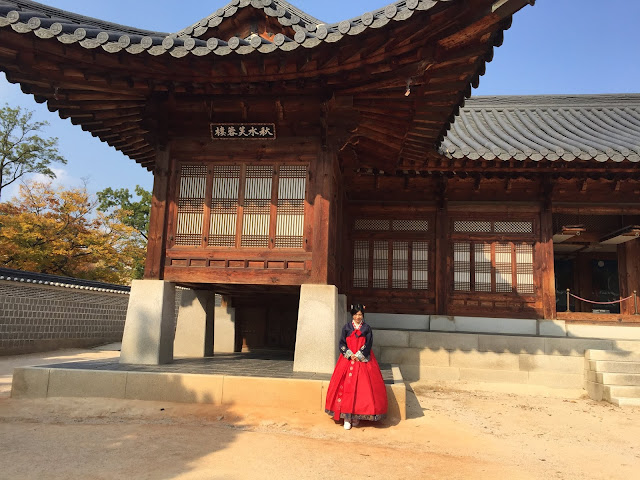After I got my Hanbok and makeover at Flowery Hanbok, off I went to the Gyeongbokgung Palace - the palace greatly blessed by heaven. Time to tick off my bucketlist! I was so excited and also somewhat nervous as I slowly made my way along towards the palace.
The Gyeongbokgung Palace was established in 1395, 3 years after the Joseon Dynasty was founded by King Taejo. After its establishment, the capital of this new dynasty was moved from Gaesung to Hanyang (former name of Seoul) with the Gyeongbokgung Palace serving as the largest and main palace alongside with the other 4 grand palaces, namely: Gyeonghuigung Palace, Deoksugung Palace, Changgyeonggung Palace and Changdeokgung palace.
I felt as if I just hopped onto a time machine when I stepped foot into the Gyeongbokgung Palace. Everything was so well preserved and every corner's so picturesque. I literally stood there for a good 5 minutes just to let everything sink in. It was so perfect to the extent that it's felt unreal.
If only I knew how to photoshop that guy out of this picture! Damn it~
In 1873, King Gojong redesigned the palace's back garden. He dug a pond with a 2-tier hexagonal islet in the middle named Hwangwonjeong Pavillion (meaning 'the Pavilion of Far-Reaching Fragrance) and the bridge across the pond was named Chwihyanggo (meaning 'intoxicated with fragrance).
Source: royalpalace.go.kr
I wish I had taken more care and attention by recording the names and meanings of all these doors/gates/buildings during my visit :/ Gyeongbokgung Palace does offer guided tours (please see the end of this blog post for more information) so tourists get to learn more about this historical place.
This building was given the name Changan-tang, (translation: a place that is always peaceful). This is a meeting place used by the king with foreign politicians.

I took this shot unintentionally and it turned out so good. It looks like a scene from a Korean drama!
Geunjeongjeon Hall is known as the Throne Hall - the most formal hall of the palace.

See the red/gold chair in the centre? That's the King's seat.
At the stairs of Geunjeongjeon Hall, a Korean old man pulled me aside and asked if I could do a few posses for him to shoot.
My favourite shot during this Gyeongbokgung trip. This photo remained as my personal Facebook profile picture for a really long time.
A wave of gratitude washed over me as I went through all these photos prior to composing this blog post. Thanks to all those kind-hearted strangers who took these photos of me wearing a Hanbok, now I get to revisit the swelling sense of I-miss-and-love-Korea whenever I want to.
Geyonghoeru Pavillion was built on the pond west of the King's living quarters. This was the place where the king threw joyous celebrations and feasts for foreign envoys and his court officials.
Gwanghwamun is the main gate of the palace. Bombed during the Korean War, Gwanghwabun Gate's structure was rebuilt in 1968 and restored to its original shape in 2010.
Just look at the crowd!
I met this cutie at Flowery Hanbok when I was returning my hanbok. Her parents thought I was Korean and asked if she could take some photos with me. It should be the other way round though - me asking if I could take photos with her because she's so freaking adorable!!!
This day was (still is) one of the greatest memories during this trip. I finally ticked "wear a hanbok" off my bucketlist. I know there will be more to come and I will definitely be back again. Maybe the next time when I wear a hanbok and go to Gyeongbokgung Palace, I will bring along a photographer and go on a guided tour so I get to learn more about the history of the palace.
- 가자 Korea Diary Part 1: Post Kimchiland Thoughts & Reasons Why I Love Korea
- 가자 Korea Diary Part 2: Preparation Tips for Korea
- 가자 Korea Diary Part 3: First Night in Korea - My Airbnb @ Hapjeong & Dinner @ HongDae
- 가자 Korea Diary Part 4: The 1st Shop of Coffee Prince @ HongDae
- 가자 Korea Diary Part 5: Traditional Side of Seoul with the Koreans - Ikseondong, Gyeongbukgong, Insadong, Cheonggyecheon
- 가자 Korea Diary Part 6: Ewha Womens University, Yonsei University, Sinchon
- 가자 Korea Diary Part 7: K-Star Road @ Apgujeongrodeo, JYP & FNC Entertainment @ Cheongdamdong & Kakao Friends Store @ Gangnam
- 가자 Korea Diary Part 8: CN BLUE Kang MinHyuk's Dad's Resturant - Hwang's Eel Restaurant 황가네꼼장군
- 가자 Korea Diary Part 9: Day Trip to Nami Island [With Vlog]
- 가자 Korea Diary 10: Filming Location of K-drama Heartstrings @ Seoul Institute of the Arts, Ansan [With Vlog]
- 가자 Korea Diary 11: Shopping Spree @ Express Bus Terminal + Eating Sulbing @ CN BLUE's Lee JongHyun's Sulbing Shop in Silim
- 가자 Korea Diary 12: I Stayed in a Traditional Korean House (Hanok) @ Seoul Lucky Guest House
- 가자 Korea Diary 13:Stylenanda Pink Hotel & Pink Cool Cafe @ Myeongdong 스타일난다 명동점
- 가자 Korea Diary 14: FNC Wow! Celebrity Space @ Myeongdong
- 가자 Korea Diary 15: A Day at Myeongdong 명동에서의 하루 - Stylenanda Flagship Store, FNC Wow!, Line Friends Store, Lotte Young Plaza
- 가자 Korea Diary 16: Tongin Sweet 통인스윗 & Miss Lee Cafe 별다방미스리 @ Gyeongbokgung 경복궁
- 가자 Korea Diary 17: Renting a Hanbok & Getting Hair Makeover @ Flowery Hanbok 꽃같은한복


































Post a Comment